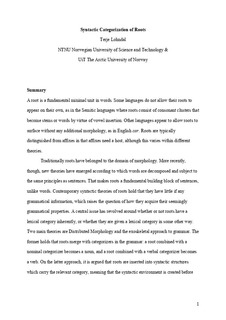| dc.contributor.author | Lohndal, Terje | |
| dc.date.accessioned | 2020-03-02T10:03:02Z | |
| dc.date.available | 2020-03-02T10:03:02Z | |
| dc.date.created | 2020-02-28T21:10:54Z | |
| dc.date.issued | 2020 | |
| dc.identifier.isbn | 9780199384655 | |
| dc.identifier.uri | http://hdl.handle.net/11250/2644577 | |
| dc.description.abstract | A root is a fundamental minimal unit in words. Some languages do not allow their roots to appear on their own, as in the Semitic languages where roots consist of consonant clusters that become stems or words by virtue of vowel insertion. Other languages appear to allow roots to surface without any additional morphology, as in English car. Roots are typically distinguished from affixes in that affixes need a host, although this varies within different theories.
Traditionally roots have belonged to the domain of morphology. More recently, though, new theories have emerged according to which words are decomposed and subject to the same principles as sentences. That makes roots a fundamental building block of sentences, unlike words. Contemporary syntactic theories of roots hold that they have little if any grammatical information, which raises the question of how they acquire their seemingly grammatical properties. A central issue has revolved around whether roots have a lexical category inherently or whether they are given a lexical category in some other way. Two main theories are distributed morphology and the exoskeletal approach to grammar. The former holds that roots merge with categorizers in the grammar: a root combined with a nominal categorizer becomes a noun, and a root combined with a verbal categorizer becomes a verb. On the latter approach, it is argued that roots are inserted into syntactic structures which carry the relevant category, meaning that the syntactic environment is created before roots are inserted into the structure. The two views make different predictions and differ in particular in their view of the status of empty categorizers. | nb_NO |
| dc.language.iso | eng | nb_NO |
| dc.publisher | Oxford University Press | nb_NO |
| dc.relation.ispartof | Oxford Research Encyclopedia of Linguistics 2020 | |
| dc.title | Syntactic categorization of roots | nb_NO |
| dc.type | Chapter | nb_NO |
| dc.description.version | acceptedVersion | nb_NO |
| dc.source.pagenumber | 1-28 | nb_NO |
| dc.identifier.doi | 10.1093/acrefore/9780199384655.013.257 | |
| dc.identifier.cristin | 1798573 | |
| dc.description.localcode | This is a pre-copyedited, author-produced version of a chapter accepted for publication in Oxford Research Encyclopedia of Linguistics 2020 following peer review. Locked until 1.2.2022 due to copyright restrictions.The version of record is available online at: http://dx.doi.org/http://dx.doi.org/10.1093/acrefore/9780199384655.013.257 | nb_NO |
| cristin.unitcode | 194,62,60,0 | |
| cristin.unitname | Institutt for språk og litteratur | |
| cristin.ispublished | true | |
| cristin.fulltext | postprint | |
| cristin.qualitycode | 2 | |
